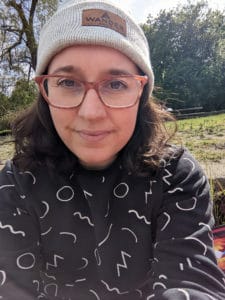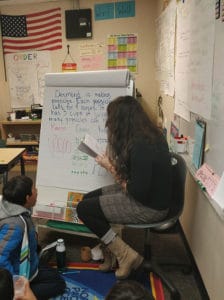School systems are complex webs of people, information, policies and practices. Each person, whether an administrator, teacher, student, or community member experiences the system differently. Because of this, when faced with systemic challenges, it can be difficult to come to an agreement on an individual challenge to address or even a similar direction to move toward.
Yet, in order to create change, we need lots of people with multiple perspectives willing to work together in order to coordinate an effective response to any challenge.

Rachel Mateo, a math interventionist, brought some of those multiple perspectives with her as she addressed the challenge of math inequity at Lowell this year. Typically, interventionists are known to work with students that have the most need and support them in growth. “But that is only a fraction of my job, I also co-teach two different grade levels, support teachers in math instruction and assessment and help with pacing at the school. I focus our school’s math goal and lead grade level meetings to discuss school-wide growth around math. I also lead math professional development and coordinate tutors to help us meet student needs,” said Mateo. In this role, she has the unique ability to provide a school-wide perspective and see the complex school system from many different vantage points, which is why she was asked by her principal to be a part of the network.

Participating in the Learning for Equity Network (LEN) provided professional connection and learning. It combined real-time instructional activity work with connection to colleagues from different schools all working towards a unified goal of culturally responsive instruction. “It gave me a space to have more conversations around a culturally responsive tool that helped to shape our instructional practice,” said Mateo. The connection and collaboration across schools in the district is intended to organize teacher leaders as they address building culturally responsive instruction into the culture of each of their schools.
In addition to connection from cohort colleagues, she met regularly with an instructional coach that served as professional support. “He was the most beneficial part of the network for me, to have a thought partner. He had me using more counting collections and I was able to discuss challenges with the school system,” said Mateo. When addressing a math equity challenge at Lowell, he supported her efforts by reaching out to contacts and provided elementary research to back her practices. “We were able to impact Lowell’s monitoring of K-5 math progress and it was nice to have someone support my thinking,” she said.
These foundational relationships formed throughout this first year serve as the backbone of the network. Trusted relationships have strengthened the organizing effort to change the culture of schools and help move participants as they work towards intelligent and innovative solutions to changing the way students furthest away from educational justice experience math.


